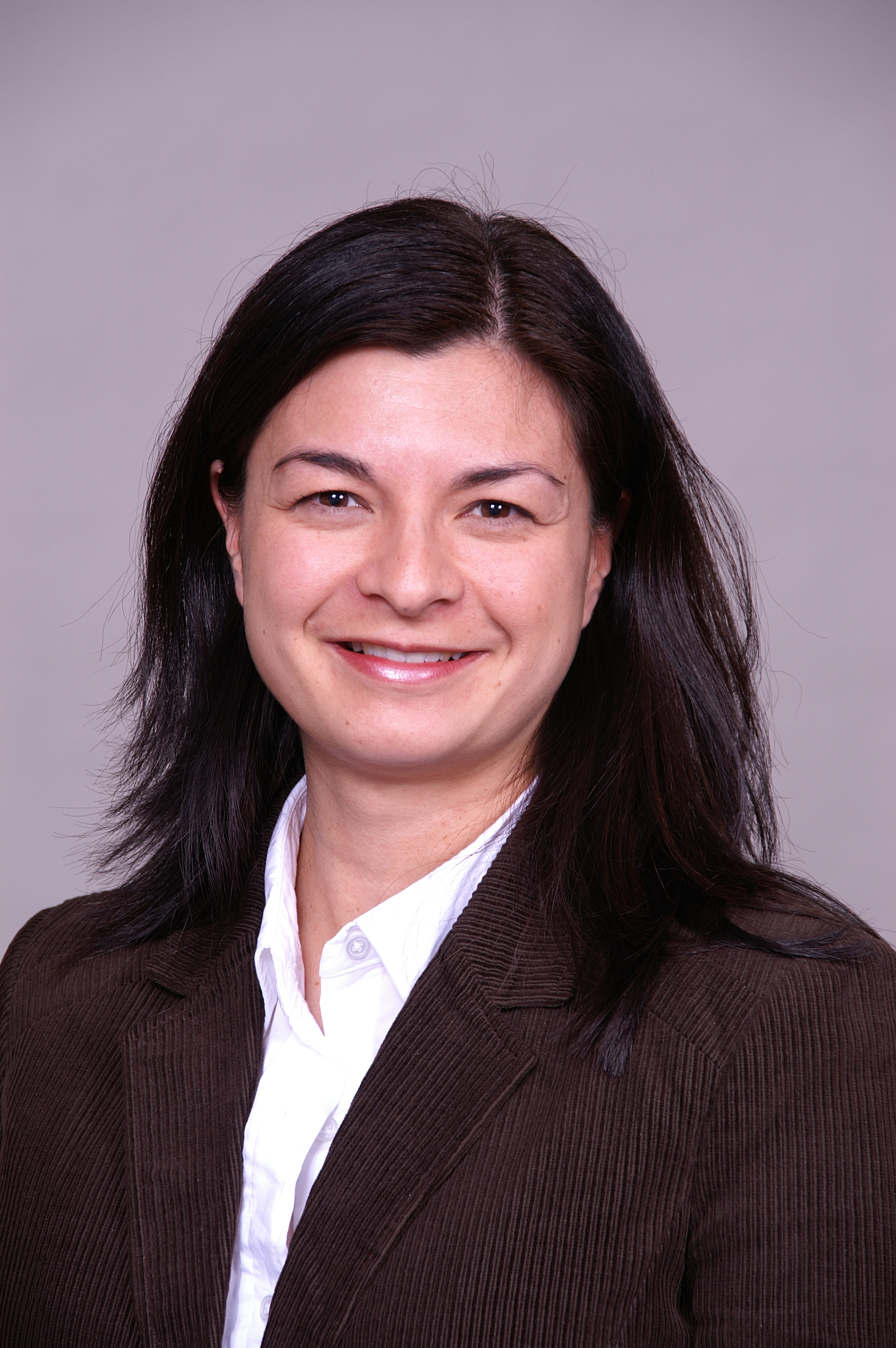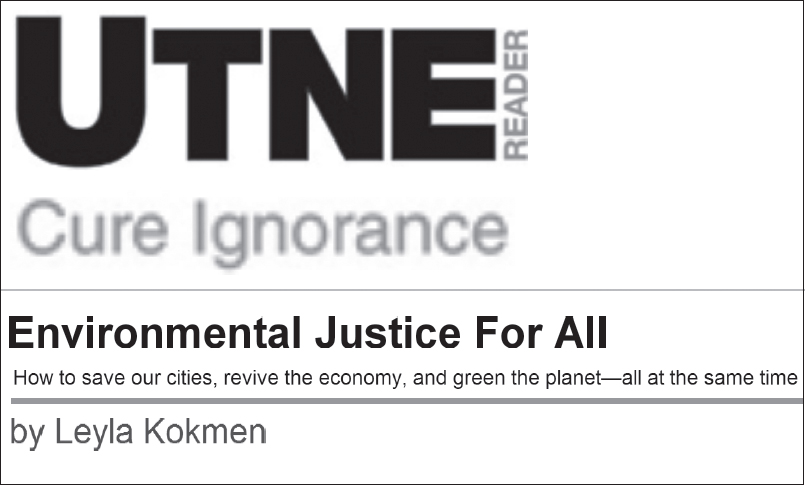Article

Leyla Kokmen
Environmental Justice for All
Leyla Kokmen is a health writer and has served on the faculty of the School of Public Health at the University of Minnesota. The following article first appeared in Utne Reader, a bimonthly magazine that reprints articles from nonmainstream media. Kokmen describes the environmental justice movement that originated in the 1970s. She also writes about issues of class and race in terms of who is exposed to risks from polluting facilities. Environmental Justice for All appears by permission of Leyla Kokmen.

Manuel Pastor ran bus tours of Los Angeles a few years back. These weren’t the typical sojourns to Disneyland or the MGM studios, though; they were expeditions to some of the city’s most environmentally blighted neighborhoods—where railways, truck traffic, and refineries converge, and where people live two hundred feet from the freeway.
The goal of the “toxic tours,” explains Pastor, a professor of geography and of American studies and ethnicity at the University of Southern California, was to let public officials, policy makers, and donors talk to residents in low-income neighborhoods about the environmental hazards they lived with every day and to literally see, smell, and feel the effects.
“It’s a pretty effective forum,” says Pastor, who directs USC’s Program for Environmental and Regional Equity, noting that a lot of the “tourists” were eager to get back on the bus in a hurry. “When you’re in these neighborhoods, your lungs hurt.”
Like the tours, Pastor’s research into the economic and social issues facing low-income urban communities highlights the environmental disparities that endure in California and across the United States. As stories about global warming, sustainable energy, and climate change make headlines, the fact that some neighborhoods, particularly low-income and minority communities, are disproportionately toxic and poorly regulated has, until recently, been all but ignored.
A new breed of activists and social scientists are starting to capitalize on the moment. In principle they have much in common with the environmental justice movement, which came of age in the late 1970s and early 1980s, when grassroots groups across the country began protesting the presence of landfills and other environmentally hazardous facilities in predominantly poor and minority neighborhoods.
In practice, though, the new leadership is taking a broader-based, more inclusive approach. Instead of fighting a proposed refinery here or an expanded freeway there, all along trying to establish that systematic racism is at work in corporate America, today’s environmental justice movement is focusing on proactive responses to the social ills and economic roadblocks that if removed would clear the way to a greener planet.
The new movement assumes that society as a whole benefits by guaranteeing safe jobs, both blue-collar and white-collar, that pay a living wage. That universal healthcare would both decrease disease and increase awareness about the quality of everyone’s air and water. That better public education and easier access to job training, especially in industries that are emerging to address the global energy crisis, could reduce crime, boost self-esteem, and lead to a homegrown economic boom.
That green rights, green justice, and green equality should be the environmental movement’s new watchwords.
“This is the new civil rights of the twenty-first century,” proclaims environmental justice activist Majora Carter.
A lifelong resident of Hunts Point in the South Bronx, Carter is executive director of Sustainable South Bronx, an eight-year-old nonprofit created to advance the environmental and economic future of the community. Under the stewardship of Carter, who [is a] MacArthur Fellowship [recipient], the organization has managed a number of projects, including a successful grassroots campaign to stop a planned solid waste facility in Hunts Point that would have processed 40 percent of New York City’s garbage.
Her neighborhood endures exhaust from some sixty thousand truck trips every week and has four power plants and more than a dozen waste facilities. “It’s like a cloud,” Carter says. “You deal with that, you’re making a dent.”
The first hurdle Carter and a dozen staff members had to face was making the environment relevant to poor people and people of color who have long felt disenfranchised from mainstream environmentalism, which tends to focus on important but distinctly nonurban issues, such as preserving Arctic wildlife or Brazilian rain forest. For those who are struggling to make ends meet, who have to cobble together adequate healthcare, education, and job prospects, who feel unsafe on their own streets, these grand ideas seem removed from reality.
That’s why the green rights argument is so powerful: It spans public health, community development, and economic growth to make sure that the green revolution isn’t just for those who can afford a Prius. It means cleaning up blighted communities like the South Bronx to prevent potential health problems and to provide amenities like parks to play in, clean trails to walk on, and fresh air to breathe. It also means building green industries into the local mix, to provide healthy jobs for residents in desperate need of a livable wage.
Historically, mainstream environmental organizations have been made up mostly of white staffers and have focused more on the ephemeral concept of the environment rather than on the people who are affected. Today, though, as climate change and gas prices dominate public discourse, the concepts driving the new environmental justice movement are starting to catch on. For instance, New York Times columnist Thomas Friedman dubbed the promise of public investment in the green economy the “Green New Deal.”
Van Jones, whom Friedman [has written about], is president of the Ella Baker Center for Human Rights in Oakland, California. To help put things in context, Jones briefly sketches the history of environmentalism.
The first wave was conservation, led first by Native Americans who respected and protected the land, then later by Teddy Roosevelt, John Muir, and other Caucasians who sought to preserve green space.
The second wave was regulation, which came in the 1970s and 1980s with the establishment of the Environmental Protection Agency (EPA) and Earth Day. Increased regulation brought a backlash against poor people and people of color, Jones says. White, affluent communities sought to prevent environmental hazards from entering their neighborhoods. This “not-in-my-backyard” attitude spurred a new crop of largely grassroots environmental justice advocates who charged businesses with unfairly targeting low-income and minority communities. “The big challenge was NIMBY-ism,” Jones says, noting that more toxins from power plants and landfills were dumped on people of color.
The third wave of environmentalism, Jones says, is happening today. It’s a focus on investing in solutions that lead to “eco-equity.” And, he notes, it invokes a central question: “How do we get the work, wealth, and health benefits of the green economy to the people who most need those benefits?”
There are a number of reasons why so many environmental hazards end up in the poorest communities.
Property values in neighborhoods with environmental hazards tend to be lower, and that’s where poor people—and often poor people of color—can afford to buy or rent a home. Additionally, businesses and municipalities often choose to build power plants in or expand freeways through low-income neighborhoods because the land is cheaper and poor residents have less power and are unlikely to have the time or organizational infrastructure to evaluate or fight development.
“Wealthy neighborhoods are able to resist, and low-income communities of color will find their neighborhoods plowed down and [find themselves] living next to a freeway that spews pollutants next to their schools,” USC’s Manuel Pastor says.
Moreover, regulatory systems, including the EPA and various local and state zoning and environmental regulatory bodies, allow piecemeal development of toxic facilities. Each new chemical facility goes through an individual permit process, which doesn’t always take into account the overall picture in the community. The regulatory system isn’t equipped to address potentially dangerous cumulative effects.
In a single neighborhood, Pastor says, you might have toxins that come from five different plants that are regulated by five different authorities. Each plant might not be considered dangerous on its own, but if you throw together all the emissions from those static sources and then add in emissions from moving sources, like diesel-powered trucks, “you’ve created a toxic soup,” he says.
“We can fight pollution and poverty at the same time and with the same solutions and methods,” says the Ella Baker Center’s Van Jones.
Poor people and people of color have borne all the burden of the polluting industries of today, he says, while getting almost none of the benefit from the shift to the green economy. Jones stresses that he is not an environmental justice activist, but a “social-uplift environmentalist.” Instead of concentrating on the presence of pollution and toxins in low-income communities, Jones prefers to focus on building investment in clean, green, healthy industries that can help those communities. Instead of focusing on the burdens, he focuses on empowerment, [for example, on] the Ella Baker Center’s Green-Collar Jobs Campaign. The initiative, according to program manager Aaron Lehmer, received $250,000 from the city of Oakland and will give people ages eighteen to thirty-five with barriers to employment (contact with the criminal justice system, long-term unemployment) opportunities and paid internships for training in new energy skills like installing solar panels and making buildings more energy efficient.
The concept has gained national attention [and became] the cornerstone of the Green Jobs Act, which authorizes $125 million annually for “green-collar” job training.
Are you convinced by the argument that taking action to protect the environment in impoverished areas can help resolve social ills? Why or why not?
While Jones takes the conversation to a national level, Majora Carter is focusing on empowerment in one community at a time. Her successes at Sustainable South Bronx include the creation of a ten-week program that offers South Bronx and other New York City residents hands-on training in brownfield remediation and ecological restoration [and] a bicycle and pedestrian greenway along the South Bronx waterfront that will provide both open space and economic development opportunities.
Carter stresses that framing the environmental debate in terms of opportunities will engage the people who need the most help. It’s about investing in the green economy, creating jobs, and building spaces that aren’t environmentally challenged. It won’t be easy, she says. But it’s essential to dream big.
“It’s about sacrifice,” she says, “for something better and bigger than you could have possibly imagined.”